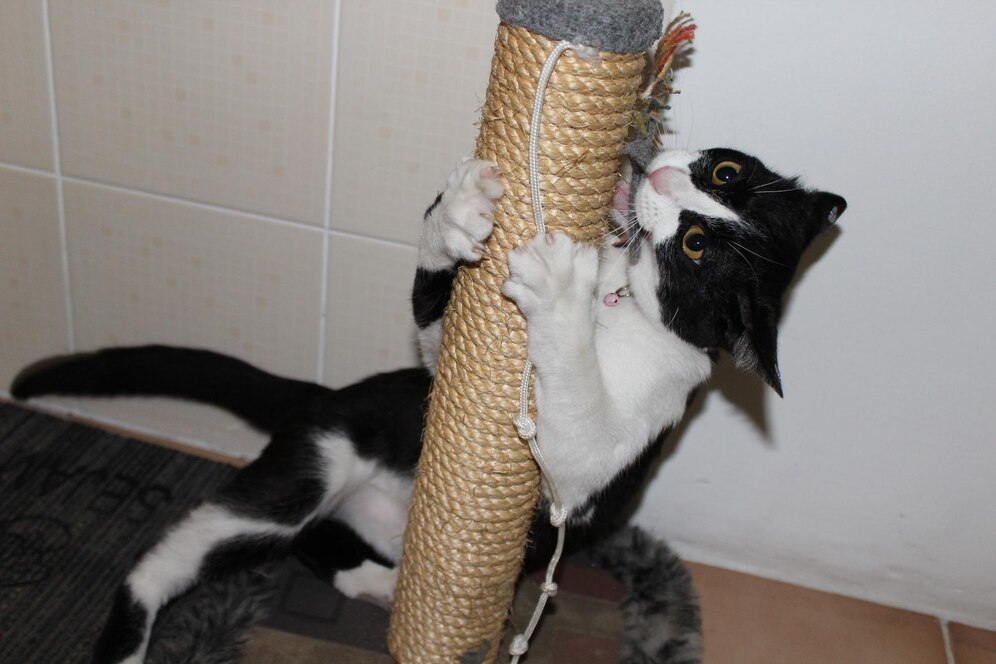Introduction
Scratching is a natural and essential behavior for cats. It helps them sharpen their claws, stretch their muscles, and mark their territory. However, when your feline friend turns their attention to your new sofa or cherished armchair, it can become a frustrating issue. The good news? You don’t need to choose between your furniture and your cat. With the right strategies, you can redirect this behavior in a healthy, stress-free way.
This guide will walk you through effective, humane ways to stop your cat from scratching furniture — while keeping them happy and your home stylish.
Why Do Cats Scratch?
Understanding why cats scratch helps you manage it more effectively. Here are some core reasons:
- Sharpening claws: Scratching removes old outer nail sheaths.
- Marking territory: Cats have scent glands in their paws.
- Stretching: It gives their back and shoulder muscles a workout.
- Stress relief: A scratched surface can be a sign of anxiety or boredom.
Knowing these motivations lets you provide alternatives that satisfy their needs.
Step-by-Step Solutions to Stop the Scratching

1. Provide Attractive Alternatives
Your cat isn’t scratching out of spite — they’re scratching because they need to. Offering suitable alternatives is the first and most important step.
Popular Alternatives:
- Scratching posts (vertical and horizontal)
- Cat trees or towers
- Corrugated cardboard scratchers
- Sisal rope-covered surfaces
Place these near areas your cat already scratches. Praise or reward them when they use the right spot.
2. Use Deterrents Wisely
Deterrents discourage cats from scratching unwanted areas without punishing them.
Effective Deterrents Include:
- Double-sided tape: Cats dislike sticky paws.
- Aluminum foil: Many cats avoid its texture.
- Furniture covers: Temporary guards that make surfaces unattractive.
- Pet-safe sprays: Scents that are unappealing to cats.
Tip: Combine deterrents with new scratching alternatives for faster results.
3. Encourage Positive Association
Make your cat’s new scratch zone the best spot in the house.
Ideas to Attract Them:
- Rub catnip on new posts
- Place toys around the area
- Use treats to create a reward system
Positive reinforcement works far better than scolding.
4. Trim Their Claws Regularly
Trimming your cat’s claws every 2–3 weeks reduces the damage scratching can cause.
Claw Trimming Tips:
- Use pet nail clippers
- Start slowly and gently
- Reward your cat with treats afterward
If you’re unsure how to trim safely, consult your vet or groomer.
5. Try Soft Nail Caps
Soft nail caps are plastic covers glued onto a cat’s claws. These prevent sharp scratches without harming your cat.
| Pros of Nail Caps | Cons of Nail Caps |
|---|---|
| Non-invasive | Needs replacing every 4–6 weeks |
| Available in fun colors | May take time for your cat to adjust |
| Safe and vet-approved | Not ideal for outdoor cats |
Table: Scratching Solutions Cheat Sheet
| Problem Area | Solution | Tools/Methods |
|---|---|---|
| Sofa corners | Use double-sided tape + nearby post | Sticky Paws, sisal-covered scratcher |
| Door frames | Block access + horizontal scratcher | Cardboard scratch pads |
| Curtains | Use vertical scratch posts nearby | Tall cat trees |
| Mattress edges | Tape + catnip-sprayed posts | Deterrent spray + redirection |
Avoid These Common Mistakes

- Declawing: This is an inhumane and painful procedure that leads to long-term health and behavioral problems.
- Yelling or punishment: This can create fear and doesn’t stop the scratching instinct.
- Using one type of post: Cats have preferences—offer variety in texture and position.
When to Seek Help
If your cat scratches excessively or appears anxious, consult a veterinarian or feline behaviorist. Sometimes, scratching is a symptom of deeper behavioral or medical issues.
Extra Tips for a Scratch-Free Home
- Place scratchers in multiple rooms where your cat spends time.
- Use interactive play to reduce stress and restlessness.
- Reward good behavior consistently.
- Refresh catnip or pheromone sprays monthly.
Conclusion: Harmony Is Possible
Cats need to scratch — it’s part of who they are. But that doesn’t mean your furniture has to suffer. With the right mix of redirection, positive reinforcement, and creative solutions, you can teach your feline friend to scratch in all the right places.
By understanding your cat’s needs and setting up your home accordingly, you create a harmonious space where both your couch and your kitty can live peacefully.
